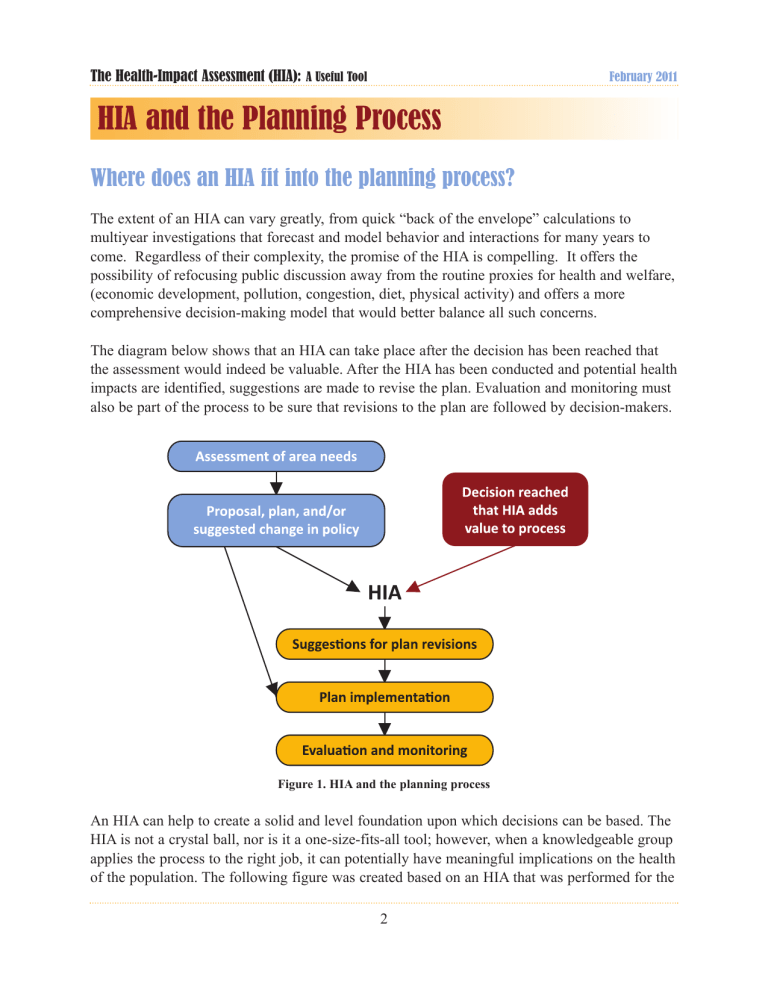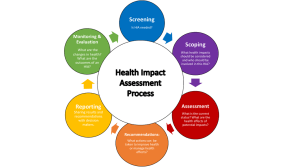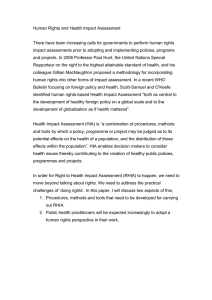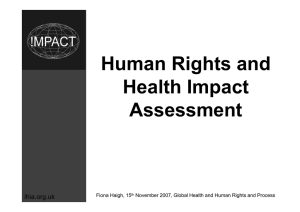HIA and the Planning Process

The Health-Impact Assessment (HIA): A Useful Tool
HIA and the Planning Process
February 2011
Where does an HIA fit into the planning process?
The extent of an HIA can vary greatly, from quick “back of the envelope” calculations to multiyear investigations that forecast and model behavior and interactions for many years to come. Regardless of their complexity, the promise of the HIA is compelling. It offers the possibility of refocusing public discussion away from the routine proxies for health and welfare,
(economic development, pollution, congestion, diet, physical activity) and offers a more comprehensive decision-making model that would better balance all such concerns.
The diagram below shows that an HIA can take place after the decision has been reached that the assessment would indeed be valuable. After the HIA has been conducted and potential health impacts are identified, suggestions are made to revise the plan. Evaluation and monitoring must also be part of the process to be sure that revisions to the plan are followed by decision-makers.
Figure 1. HIA and the planning process
An HIA can help to create a solid and level foundation upon which decisions can be based. The
HIA is not a crystal ball, nor is it a one-size-fits-all tool; however, when a knowledgeable group applies the process to the right job, it can potentially have meaningful implications on the health of the population. The following figure was created based on an HIA that was performed for the
2
The Health-Impact Assessment (HIA): A Useful Tool February 2011
Derby-area Redevelopment in Historic Commerce City, Colo., and demonstrates how a project seemingly outside of the health sector has the potential to have lasting health impacts on a population.
Figure 2. The potential health impacts of land redevelopment, an adaptation based on an HIA performed for a Derby-area redevelopment project in Colorado
Performing an HIA is a helpful way to see the effects a potential project or plan may have before the plan is approved. As demonstrated in the land-redevelopment diagram above, HIAs consider not only multiple aspects of health, but economic factors. This allows an HIA to not only impact community-health determinants, but quality of life at the individual level. HIAs are designed to integrate both promotion of health and protection of the community, making them beneficial and worthwhile to perform. HIAs are performed regularly, often as part of a mandated process, in many other areas of the world including Europe and Canada, and the practice is becoming increasingly popular in the U.S.
Although the concept of HIA is relatively new to the U.S., similar assessments take place routinely as part of planning processes. Environmental-impact assessments (EIA), social-impact assessments (SIA), and traffic-impact studies (TIS) are all methods to examine the effects of proposed projects. The National Environmental Policy Act (NEPA) is one existing regulatory measure, which was implemented in January of 1970 by the Environmental Protection Agency
(EPA). NEPA requires federal agencies to prepare environmental-impact studies (EIS). The purpose of the EIS is to assess a project’s potential impacts on the environment.
3
The Health-Impact Assessment (HIA): A Useful Tool February 2011
Now, with heavy priority placed on health and current aims to decrease healthcare costs, HIAs should become increasingly useful tools in the planning process. The Centers for Disease
Control and Prevention (CDC) branch of the U.S. Department of Health and Human Services
(DHHS) recognizes that factors outside of the health sector impact the health of populations.
Dan Kass, Deputy Commissioner for Environmental Health in New York explains, “To have true control of your health is not just about what you can do as an individual, but what can be done at the community level” (“The Mayor wants you to Lose Some Weight.” Wall Street
Journal . 4 January 2011). Examples of successful use of HIAs include raising awareness of health issues in Polk County, Fla.; confronting the loss of farmland and green space in Delaware
County, Ohio; and addressing physical inactivity in Tri-County, Colo.
The new U.S. health-promotion and disease-prevention plan, Healthy People 2020 , emphasizes a population-based perspective incorporating multiple determinants of health. Healthy People
2020 comprises the most recently released set of goals and objectives developed every 10 years by the U.S. DHHS. The goals and objectives reflect science-based evidence and are designed to guide national health efforts. With the growing national recognition that determinants of health lie outside of the traditional health sector, Healthy People 2020 became the first set of objectives published that recognizes the importance of HIAs in the planning process. Healthy
People 2020 describes five defining characteristics of HIAs:
1. A focus on a specific policy, program, or project proposal
2. A comprehensive consideration of potential health impacts, positive and negative
3. A population-based perspective incorporating multiple determinants and dimensions of health.
4. A multidisciplinary systems-based approach
5. A transparent approach that is highly structured but sufficiently flexible to confront a wide range of proposals.
In addition to these five characteristics, the World Health Organization (WHO) emphasizes a democratic approach to conducting an HIA through the involvement of any and all citizens and stresses consideration of vulnerable populations within the community.
4




